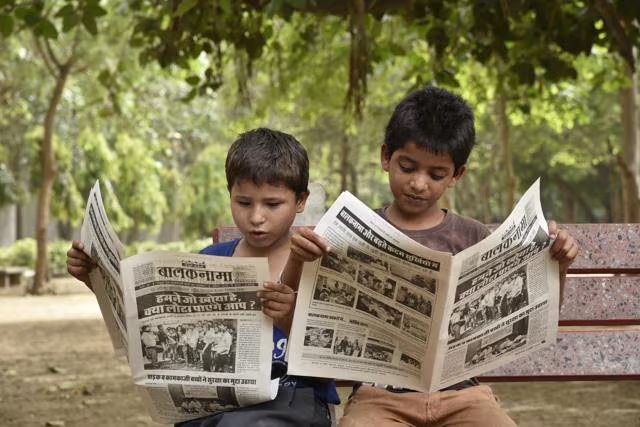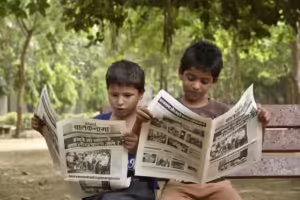In modern times, where the internet and social media are reigning supreme, newspapers and magazines are relics from the past. However, traditional forms of media pull their weight in value even in the modern information-driven world and benefit children immensely. Reading has always been a valuable activity, especially for children. It raises their knowledge, their abilities, and helps them grow. These printed materials can introduce children to new ideas and improve language.
Do you know? Children who read for only 20 minutes a day can expose themselves to nearly 2 million words yearly. Regular reading has thus greatly helped children in language and even overall academic performance.
As digital media becomes ever more pervasive, understanding the value of traditional reading is crucial, especially for children whose formative years shape lifelong learning habits. In this blog, we will explore in depth how reading newspapers and magazines positively impacts children’s learning and overall development.
Why Do Newspapers Matter for Children?
Newspapers contribute to the development of children. They carry information on a whole gamut of issues that assist the children in developing awareness about the world around them. Reading newspapers exposes them to contemporary events, social problems, and general knowledge in simpler words. Newspapers contribute to curbing curiosity and encourage critical thinking, making children more alert and knowledgeable about the global scene.
Newspapers Build a Reading Habit
It will coach children to read regularly. As the newspaper is printed on a daily basis, children can always practise reading on different topics covered, such as sports, entertainment, and science. The reading of newspapers exposes children to diverse writing styles, hence improving vocabulary and interpretation. This reading allows children to be disciplined and regular qualities that are likely to affect success in school.
Newspapers Help Learn Through Varied Content
Newspapers are a very rich source of knowledge, as they print news about almost everything occurring around the world. They also carry news stories, opinion columns, puzzles, and cartoons, catering to all interests. Not everything they learn in school is covered in textbooks. Children get to learn about environmental issues, new technological advancements, or cultural events, thus developing an ever-broadened horizon.
To download pre-school worksheets, click here
10 Benefits of Reading Newspapers and Magazines for Children
Reading newspapers and magazines is highly beneficial for children. It exposes the children to issues in systematically verified forms, ranging from news on global current issues to scientific insights, culture, and even entertainment. Unlike digital content, it fosters focused and intentional reading, which benefits better understanding and retention.
Regular reading of newspapers and magazines would help children gain knowledge and hone their thinking skills while fostering a love for reading that would last a lifetime.
It allows children to be extremely sensitive towards the world they live in and become focused individuals with a lifetime love for reading. Newspapers and magazines present information in fun and engaging ways.
They make learning enjoyable while helping children acquire some of the most important skills that they will use throughout their lives. Here are some benefits of reading newspapers and magazines.
-
Enhancing Vocabulary and Language Skills
When children read a newspaper and magazines, they come across so many new words. This helps them build a bigger vocabulary, making it easier for them to express themselves. Besides this, different styles of writing in newspapers and magazines teach children to form good sentences and write better. Gradually, this improves the way children understand and use language.
-
Boosting General Knowledge
Reading newspapers enables the child to access actual information about many things, such as current events, science, sports, and much more. This helps them know what is happening around the world and in many subjects.
Most of the magazines focus on specific interests, and things like animals or space do really interest children, so they are great at making learning fun.
For example, a child who loves nature can learn much about animals and the environment by reading a magazine like National Geographic Kid.
-
Learning through Varied Content
Newspapers are a rich source of diverse content. Kids have access to different sections like science, history, arts, sports, and even puzzles—all curated to provide a broad knowledge base. This variety enhances a child’s ability to read across multiple topics, making them more versatile learners. Unlike digital platforms, which often rely on algorithms that limit children to specific content based on previous preferences, newspapers expose children to stories they might not actively seek but could develop an interest in.
-
Developing Critical Thinking Skills
Children learn the skills of critical thinking when reading news stories. It would make them think of “is this really true?” or “what does this mean to me?” children start to grasp what is fact, what’s opinion, and what to do with either.
They become more thoughtful and make better choices. A Pew Research Center study has learned that though 82 percent of the children aged between 8-12 consume online news, by using sources that include YouTube and social media, only 48 percent of them were able to tell which one is a fact and which is an opinion of digital media. If compared to the children who read traditional sources like newspapers, 72 percent can clearly differentiate between the two. This underscores the importance of introducing newspapers as a foundation for media literacy. Overall, It’s in a child’s reading journey when children eventually get proficient and truly understand the world.
But with so much digital information it’s sometimes hard for kids to distinguish fact from opinion. Newspapers tend to be laid out on easily viewed pages with well-labeled sections like news, editorials, and features that help kids tell the difference between reporting and opinions. This trains the mind to approach information analytically-a knack that will be extremely useful in a world fast filling up with rumors masquerading as facts online.
-
Encouraging a Lifelong Habit of Reading
When children start reading newspapers and magazines early, they are more likely to develop a love for reading. If they enjoy it, they will continue reading as they grow older.
According to a study by the National Literacy Trust, children who engage in daily reading for enjoyment are three times more likely to read above the level expected for their age compared to those who don’t.
This is important because children who read more often tend to do better in school. They are also more likely to explore new ideas and learn about different cultures, which helps them become smarter and more open-minded. The early exposure of children to a newspaper can create a sense of marking time every day in focusing on reading, and this will facilitate and develop a lifelong love for learning through the act of strengthening literacy.
-
Language Acquisition through Formal Text
Unlike social media, where casual language dominates, newspapers expose children to more formal language, which is critical for academic success. It has been established by the International Reading Association that children who read newspapers are exposed to about 28% more words than children who rely primarily on digital content. The diversity of vocabulary connected with newspapers makes this reader an excellent tool for improving writing, comprehension, and verbal expression.
-
Inspiration for Research and Projects
Newspapers and magazines are really great sources for such goals as secondary and higher-learned students usually look for relevant ideas for their research paper and assignment purposes.
They actually reveal recent discoveries, innovation, and development that can truly offer insight into new concepts and advancements in nearly every field. That is why students use newspapers, not only to gain information but also to stimulate their creativity and further direct them on academic projects.
-
Fostering Empathy and Awareness of the World
By reading about events happening around the world, children can learn about different cultures, lifestyles, and challenges people face. This helps them develop empathy, which means they understand and care about how others feel.
Reading also makes them more aware of global issues, such as climate change or poverty or political conflicts—helps them develop critical thinking and problem-solving skills that are applicable beyond the classroom.
-
Screen-Free Time and Improved Focus
Indeed, since most of America’s children spend about 7 hours a day staring at screens, Common Sense Media suggests that screen-free alternatives such as reading newspapers will go a long way to boost mental well-being and focus. Making time to read physical newspapers provides the kid with quiet time away from sensory media. Kids who engage in screen-free activities like reading have much better sleep patterns, improved attention spans, and more capacity for focus.
It is also a must for children to focus for a longer period while reading newspapers and magazines. Doing so will foster attention and concentration in the child. As opposed to digital screens, which are filled with distractions, reading a printed magazine or newspaper keeps a child focused on a single task. Gradually, this can develop his ability to concentrate, proving very helpful in both school and real life.
-
Building a Sense of Achievement
When a child finishes reading an article or a section of a magazine, they feel proud of what they’ve accomplished. This boosts their confidence and encourages them to keep reading.
As they read more, they will feel even more capable and ready to take on bigger challenges, such as reading longer articles or more difficult books. This sense of achievement motivates them to continue improving their reading skills.
-
Stay Informed About the Latest Innovations and Discoveries
By reading news, children can update themselves with other subjects like what’s going on in this world, politics, sports, entertainment, science, and so on. So if somebody’s discovered a breakthrough treatment for diabetes, they will know right away from the news.
News does not just keep one engaged with current events but also helps grow knowledge. Over time, it contributes to building an educated and responsible society, reduces misinformation, and illiteracy.
-
A Great Way to Reduce Stress
Reading magazines that focus on a child’s interests is a fantastic way to unwind and lower stress. They feel refreshed and energised after diving into their favourite magazine.
Magazines often offer new ideas and inspiration with each flip of the page. Plus, if children find something fascinating, saving it for later can be a mood booster and give you something enjoyable to look forward to.
-
Enhancing Problem-Solving and Analytical Skills
In addition to giving news, newspapers are full of puzzles, crosswords, and games that challenge the child to think logically and solve problems. By working on such activities, children improve their problem-solving skills and analytical thinking skills, which are useful for both school and everyday life.
Puzzles such as Sudoku, crosswords, and trivia games found in newspapers are good exercises for the brain. According to Stanford University, children who regularly solve puzzles develop better spatial and cognitive abilities, and they show 13% greater improvement in maths and logical reasoning.
-
Engaging Families in Discussions
Newspapers offer family opportunities for conversation, making it easy for parents and children to find common ground through shared reading. This allows for meaningful conversations on events happening, social issues, and topics they may be interested in. Through conversations, a child can be supported in their growth to understand critically and make sense of things in the world around them.
A study by Journal of Early Childhood Literacy found that children who discussed newspaper articles with their parents developed better critical thinking skills. It also adds a 32 percent greater rate of reading comprehension as compared to children reading the newspaper independently. Here it can be seen how it could make reading newspapers interesting, and at the same time highly effective.
How to Encourage Newspaper Reading in the Children in 2024-25?
Featuring many benefits, how would parents and teachers be able to get children reading newspapers when screens are absorbing the time now?
- Start with Familiar Pages
Let the children begin with a fun-to-read comics, sports, or science page. When they get excited, then they’ll gradually start with more serious pages, such as current events or editorials.
- Establish Routine Reading
Set a specific time for every day to read the newspaper. It could be right after breakfast or right before bed, as in hearing stories. Routine sets in at a very young age.
- Engage Them in Family Debates
Articles can be dinner table topics. Ask them for opinions of some things on which they have thoughts and teach them critical thinking of their point of views .
- Provide Access to Both Print and Digital Media
For children who are already addicted to screens, a digital version of newspapers with interactive elements may be easier to get them into the habit of reading.
- Start with children’s newspapers
There are plenty of publications that come out with child-specific newspapers, such as The Week Junior or National Geographic Kids, which present news in a fun way for younger readers to learn.
Final Words
Reading newspapers and magazines really helps children and has many lifelong benefits. It teaches something new to children, increases vocabulary in the language, makes them think profoundly, and cares for others.
This reading habit, if developed at a younger age of life, will follow this child throughout his life, making him intelligent and wise. So, parents and teachers must encourage children to read newspapers and magazines because it is fun for them to learn.
To read more about Early Childhood education and parenting ideas, click here



